This Bulgur pilaf is a Middle Eastern-inspired recipe made in just one pot. It features nutty bulgur wheat sautéed with veggies and spices and then simmered in a rich broth until perfectly fluffy.
It is quick to make in less than 30 minutes, endlessly customizable, and a delicious way to vary your weekly menu.
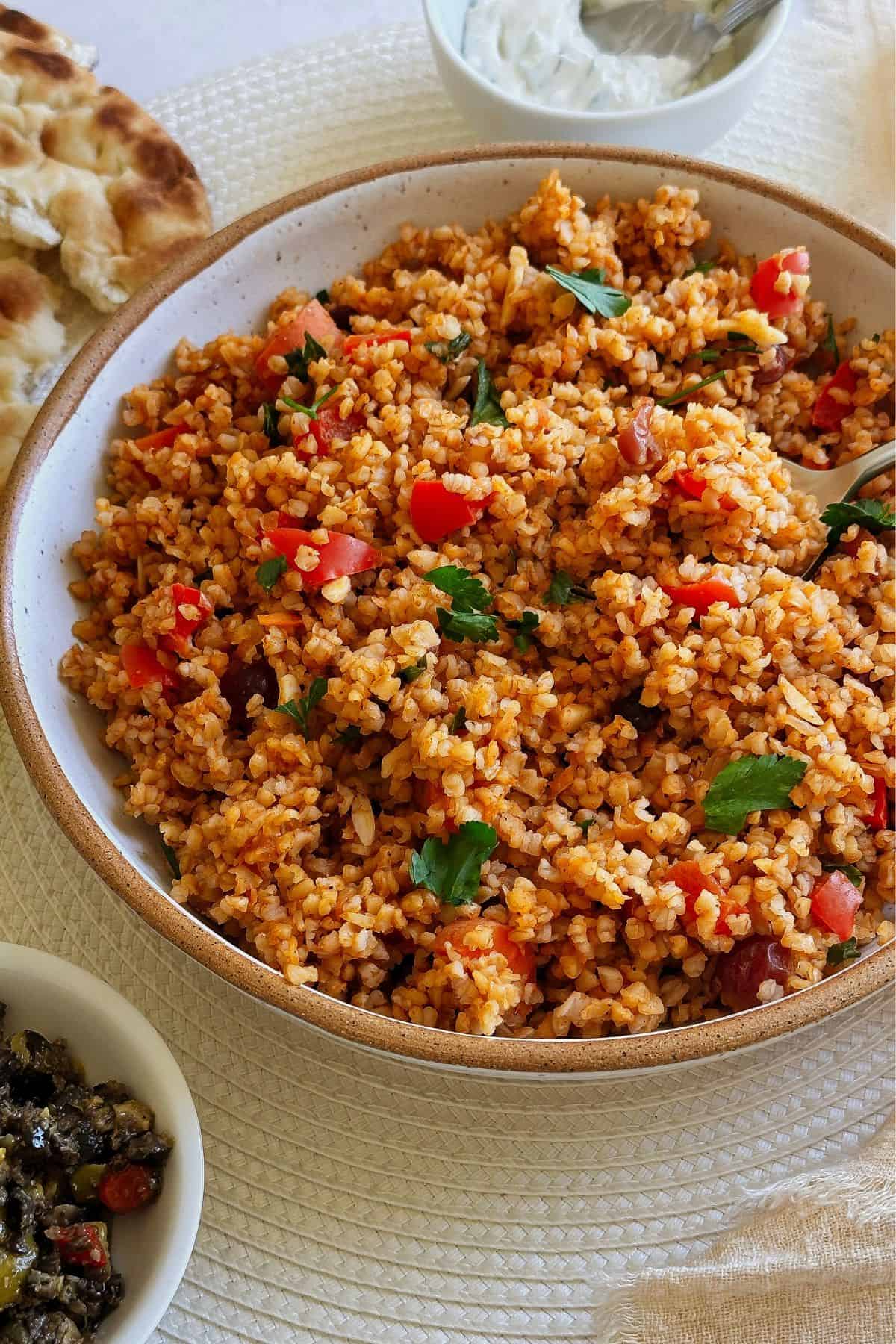
This recipe comes to you because I love bulgur!
This is a strange origin love story, but when 90-second pouches hit grocery shelves in the 2000s, my mom would stock up, and I’d happily devour them like they were gourmet cuisine. I was hooked and bought them for my pantry.
When they began making bulgur in the pouches, it became one of my favorites.
So, between microwave bulgur pouches and store-bought tabbouleh (often mixed), I guess you could say my love affair with bulgur was destined to happen and evidence that sometimes the path to culinary love is paved with convenience foods.
For other delicious grain dishes, try Arabic Rice With Vermicelli, Instant Pot Cilantro Lime Rice, or Simple Instant Pot Yellow Rice.
Jump to:
Why You'll Love This Recipe
- Bulgur is not rice! So now you have options!
- Comes together in one pot with minimal effort.
- Uses all wholesome ingredients.
- Great as a side dish or bulked up with tofu, tempeh, or chickpeas for a main course.
- This dish is great to make in batches and meal prep.
What Makes Something a Pilaf?
A pilaf is a dish where grains like rice, bulgur, or quinoa are cooked in a seasoned broth with aromatics, herbs, veggies, proteins, or sometimes vermicelli mixed in like in Arabic Rice With Vermicelli.
What sets pilaf apart is the cooking technique. The grains are typically sautéed in oil or butter before simmering in liquid, which enhances their flavor and keeps them from clumping together.
Ingredients
Round up these simple ingredients for some serious good bulgur pilaf. See the recipe card for quantities.
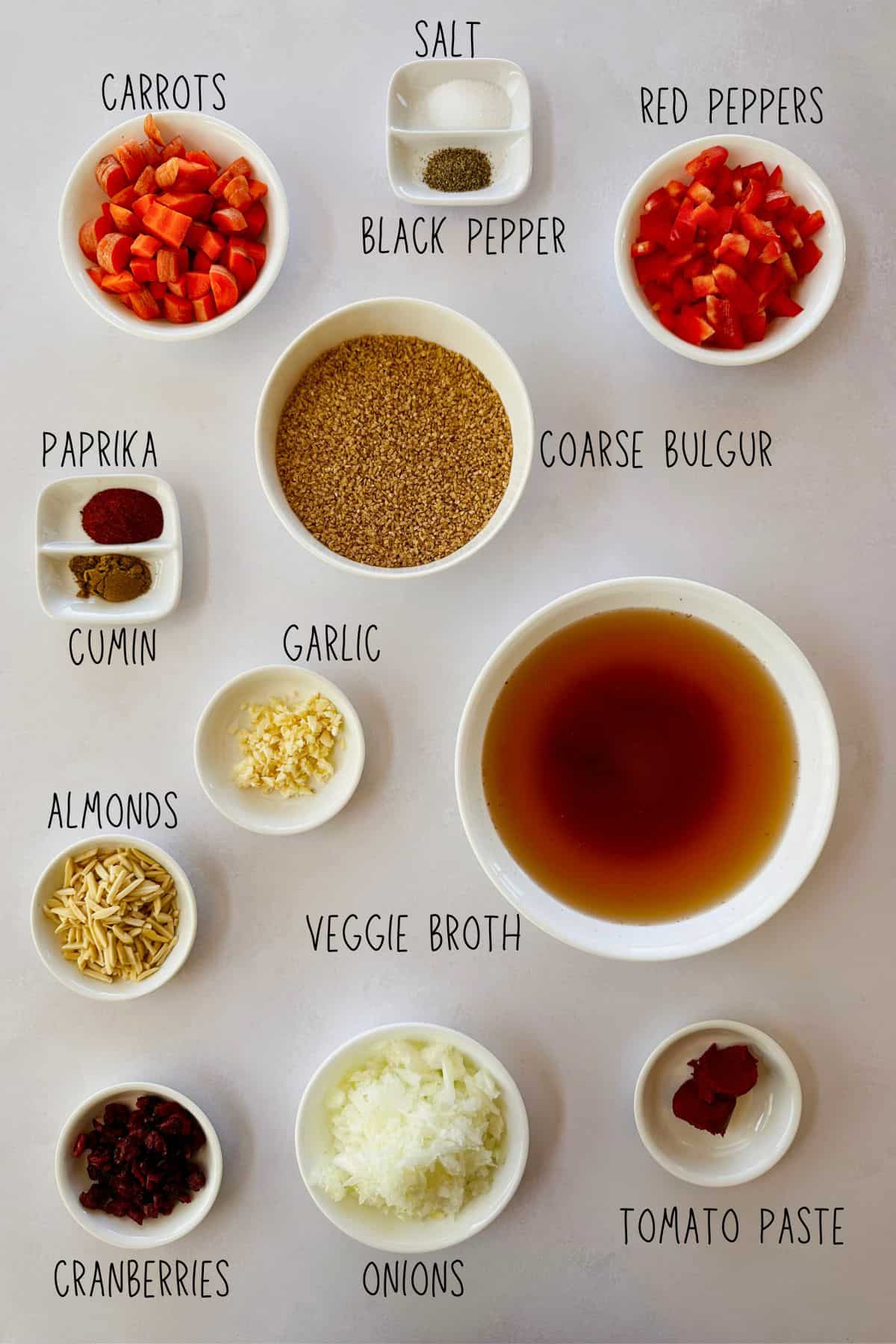
What is Bulgur?
Bulgur, a staple in Middle Eastern and Mediterranean cuisine, is a whole grain made from cracked wheat berries that are parboiled, dried, and ground into different sizes, giving it a quick-cooking quality and a slightly nutty flavor.
When buying bulgur, you’ll notice it’s categorized by grind size - fine, medium, and coarse. Sometimes, it is labeled with numbers depending on the brand (e.g., #1 for fine, #2 for medium, #3 or #4 for coarse - the numbers also vary by brand).
Fine bulgur, often used in dishes like tabbouleh, has a soft, fluffy texture and requires little to no cooking, usually just soaking.
And bulgur isn’t just a pretty grain. It packs some serious muscle with about 17 grams of protein per cup plus 26 grams of dietary fiber.
There is no need to rinse the bulgur unless the package says something different or you bought it from a bulk bin and it seems too dusty. It’s made from pre-cooked wheat berries that have already been washed and parboiled, so it’s good to go as is.
Use a medium or coarse grind for this recipe.
Variations
- Incorporate chili flakes or harissa paste for a spicy kick.
- Add cooked lentils, tofu, tempeh, or chickpeas for a one-pot main dish.
- Use the pilaf as a stuffing for bell peppers, zucchini, or eggplants.
How To Make Bulgur Pilaf
Roll up your sleeves. Here are some pics of how it is done. See the recipe card for detailed directions.

Step 1: Heat vegan butter in a saucepan over medium heat. Add onion, garlic, carrots, and bell peppers; sauté for 4-5 minutes until slightly softened.
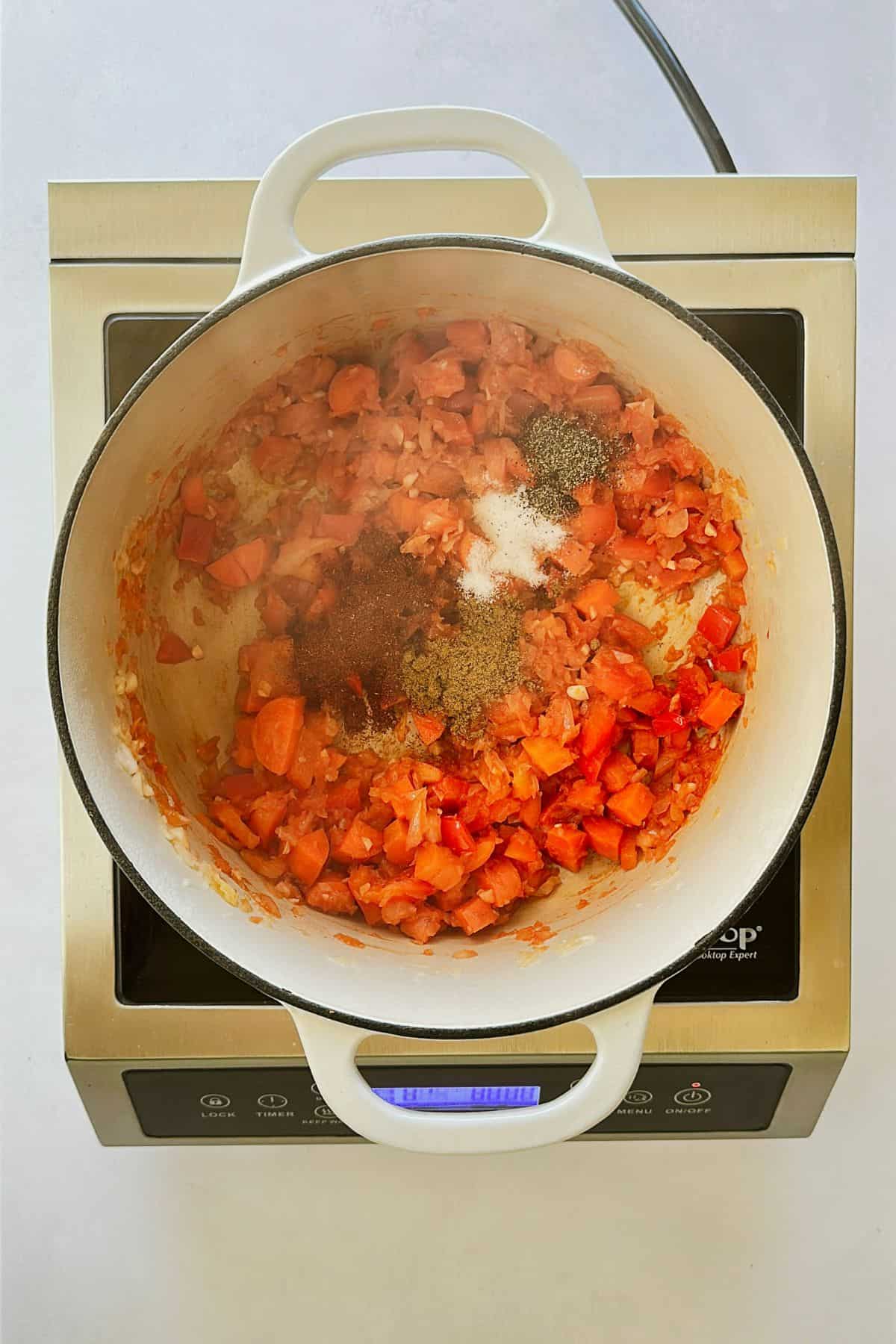
Step 2: Stir in tomato paste and cook for 2 minutes. Add salt, black pepper, paprika, and cumin; stir for 30 seconds.
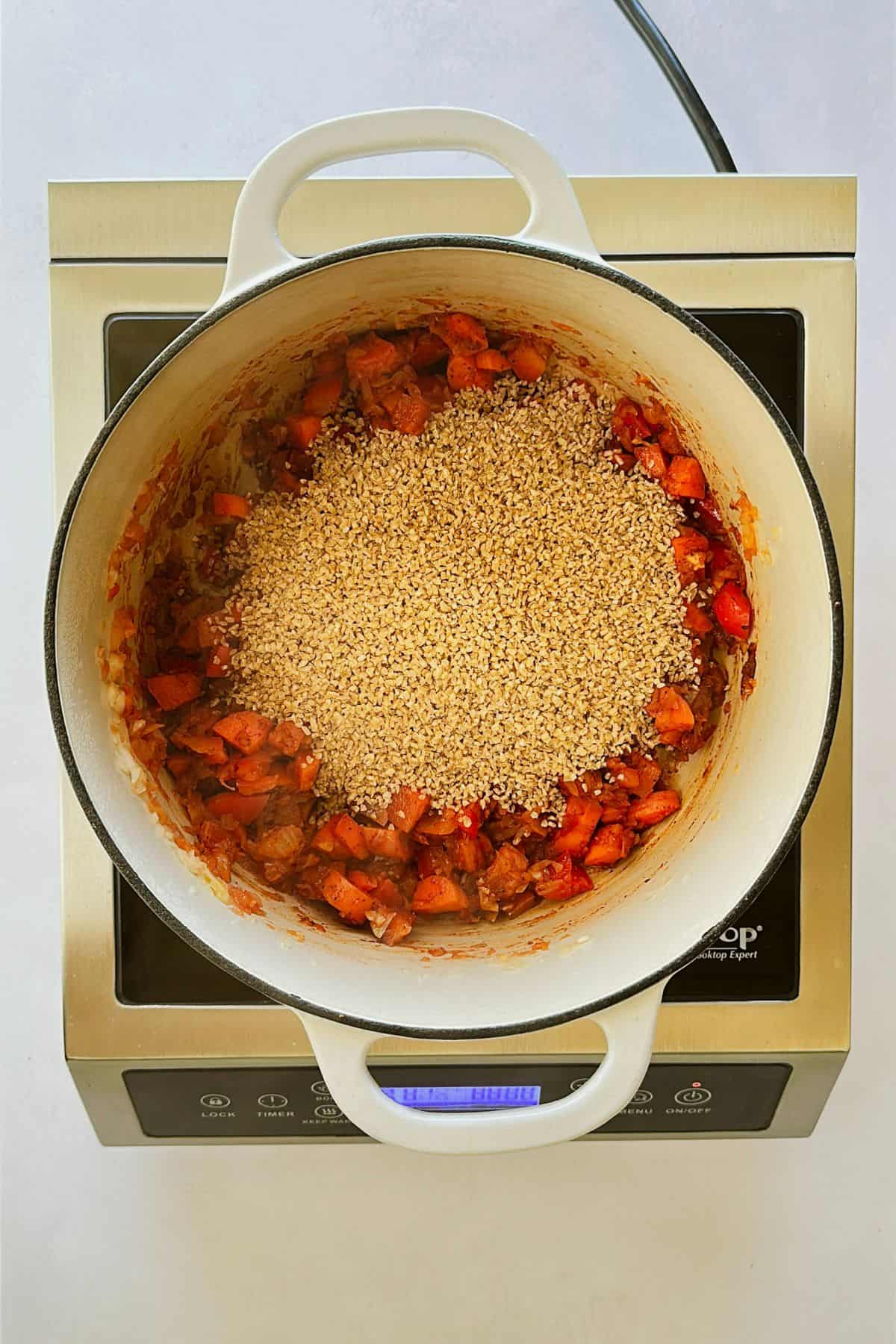
Step 3: Add bulgur, stirring to coat. Sauté for 1-2 minutes to enhance flavor.
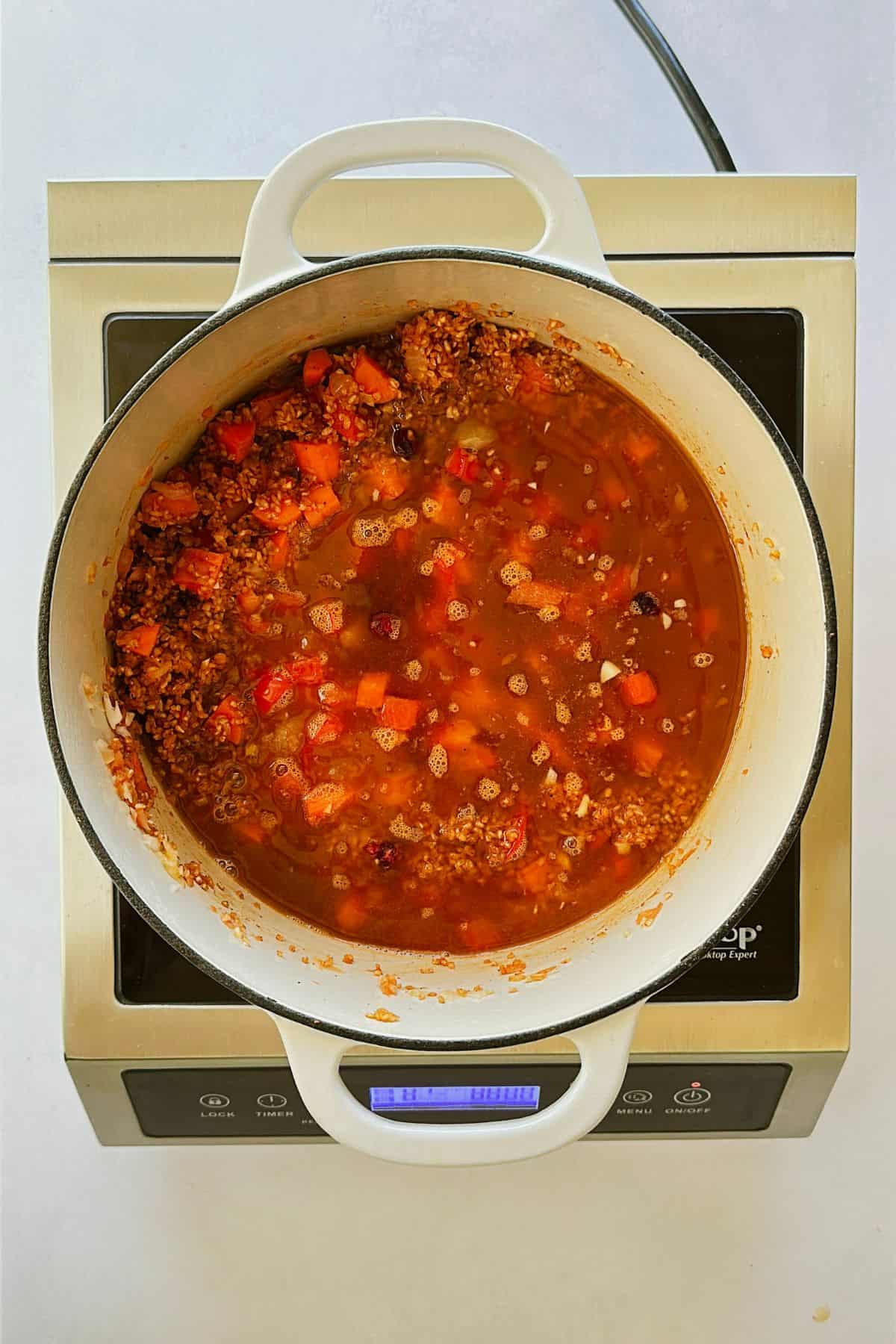
Step 4: Pour in vegetable broth and cranberries. Bring to a boil, reduce heat, cover, and simmer for 15-20 minutes until liquid is absorbed.

Step 5: Remove from heat, then fluff with a fork. Stir in toasted almonds or pine nuts.
Top Tips
Use a pot that’s big enough to handle bulgur’s growth spurt - it more than doubles in volume once liquid is absorbed.
Vegan butter adds a slight creaminess and enhances the nuttiness of the bulgur, making the pilaf even more yummy. I recommend it rather than using olive oil. With that said, if you must use it, it will still be delicious.
Serving Suggestions
- Top the bulgur with red onions, drizzle olive oil, parsley, and/or olives, and eat it straight with a spoon or scoop it up with heated pita bread or naan.
- Add diced tomatoes, olives, and artichoke hearts. Sprinkle with fresh oregano and vegan feta cheese.
- Combine it with a fresh Tabbouleh Salad and a dollop of High-Protein Low-Carb Lupini Bean Hummus for a Mediterranean-inspired plate. Add warm pita bread and some marinated olives to complete the spread.
- Top with pomegranate seeds.
- Pack bulgur pilaf in a meal-prep container with a side of Mediterranean Cucumber Tomato Salad, Roasted Chickpeas, and a drizzle of Lemon Herb Tahini Sauce, Vegan Cilantro Lime Dressing, or Vegan Tzatziki for a quick, healthy lunch.
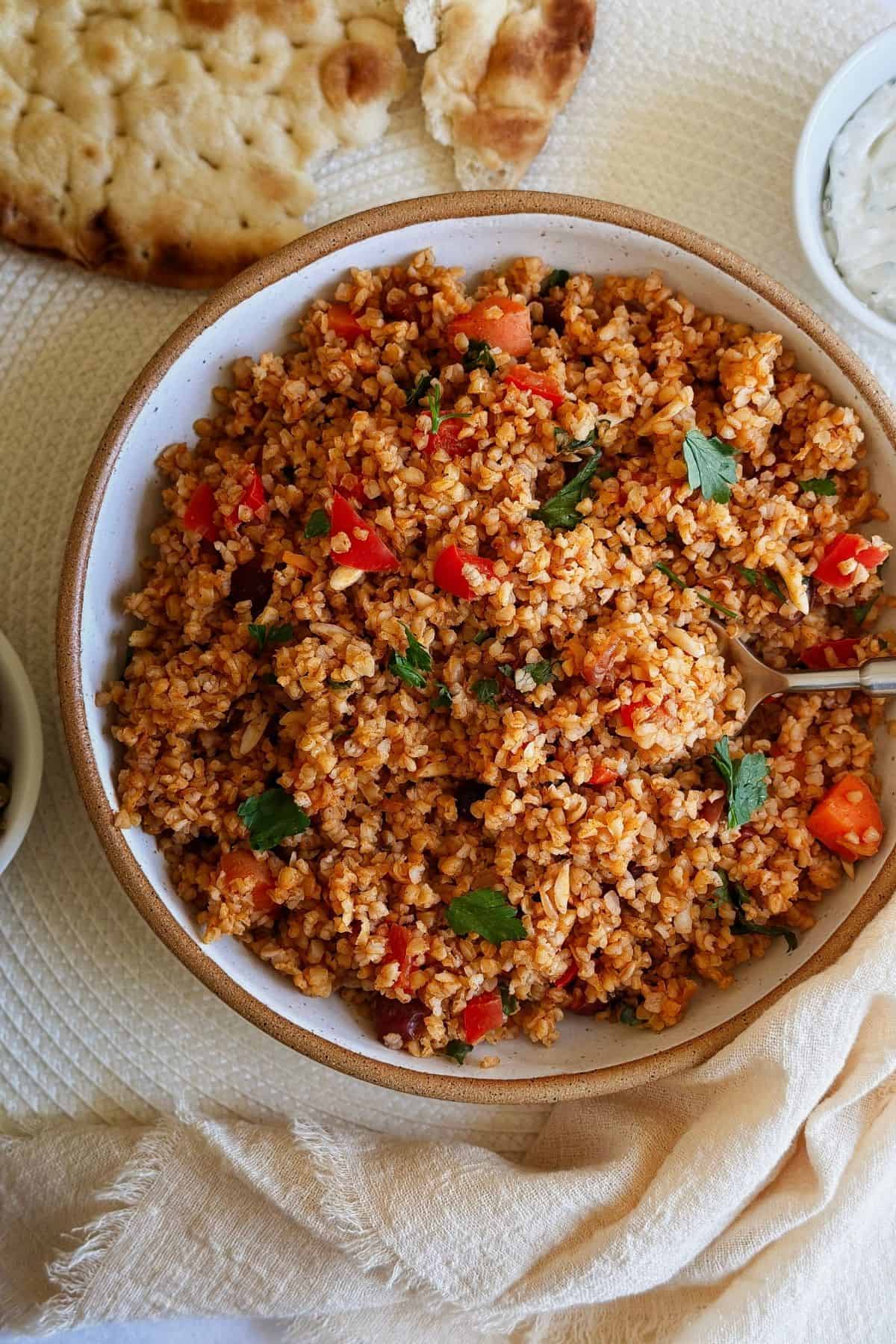
Storage
- Store leftover bulgur pilaf in an airtight container in the refrigerator for up to 4 days. Allow it to cool completely before sealing to prevent excess moisture buildup.
- Bulgur pilaf freezes well! Transfer it to a freezer-safe container or bag, removing as much air as possible, and freeze for up to 3 months. Label it with the date for easy tracking.
- Add a splash of water or broth to keep it moist, then heat in 30-second intervals in the microwave, stirring in between. For the stove, warm it in a skillet over low heat with a drizzle of olive oil or a few tablespoons of water, stirring occasionally until heated through.
Recipe FAQS
Bulgur is available at many grocery stores, typically in the grains, international, or natural foods aisle. Popular brands like Bob’s Red Mill are often stocked at major supermarkets and health food stores. You can also find bulgur at specialty stores with Middle Eastern ingredients or on Amazon.
No, bulgur is not gluten-free because it is made from wheat, which contains gluten. If you need a gluten-free alternative, try using quinoa, millet, buckwheat, or cauliflower rice instead.
Bulgur and cracked wheat are similar but not the same. Bulgur is pre-cooked and parboiled, while cracked wheat is raw and requires longer cooking.
More Delicious Vegan Side Dish Recipes

Bulgur Pilaf With Vegetables
Ingredients
- 2 cups bulgur coarse
- 2 tablespoons vegan butter or olive oil
- 1 medium onion finely chopped
- 1 cup carrots diced
- 1 cup bell pepper diced
- 4 cloves garlic minced
- 1 ½ tablespoons tomato paste
- 3 ½ cups vegetable broth
- 1 teaspoon salt or to taste
- ½ teaspoon black pepper
- 1 teaspoon paprika
- 1 teaspoon cumin
- ¼ cup dried cranberries or raisins
- ¼ cup slivered almonds or pine nuts
- ¼ cup chopped parsley
- Vegan Tzatziki optional
Instructions
- Sauté the Aromatics: Heat vegan butter in a medium saucepan over medium heat. Add the chopped onion, garlic, carrots, and bell peppers, and sauté until softened, about 4-5 minutes.
- Add Tomato & Spices: Stir in the tomato paste, cooking for another 2 minutes until fragrant. Add salt, black pepper, paprika, cumin and stir around for 30 seconds.
- Toast the Bulgur: Add the bulgur, stirring well to coat it in the tomato mixture. Sauté for about 1-2 minutes to enhance its nutty flavor.
- Simmer: Pour in the vegetable broth and cranberries, bring to a boil, then reduce the heat to low. Cover and simmer for 15-20 minutes, or until the liquid is absorbed.
- Add Nuts and Parsley: Remove from heat then fluff with a fork. Stir in the slivered almonds and parsley.
- Serve & Enjoy: Garnish with more chopped parsley and serve warm topped with cool and refreshing vegan tzatziki.

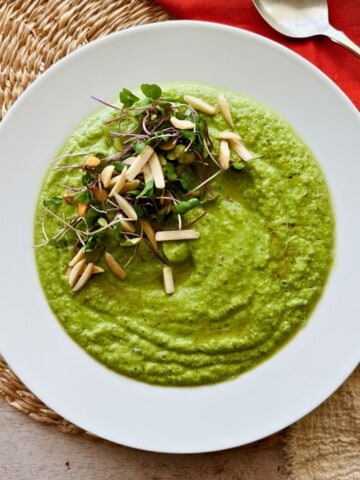





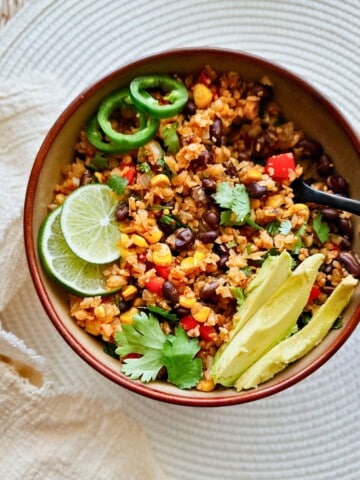

Regi Pearce says
This is super easy to make in one pot and comes together in under 30 minutes- really less than that. The addition of dried fruit and nuts adds the perfect balance of sweetness and crunch that I love. The dish works just as well as a side or a hearty main, and with the vegan tzatziki, it is so good - you gotta try it.